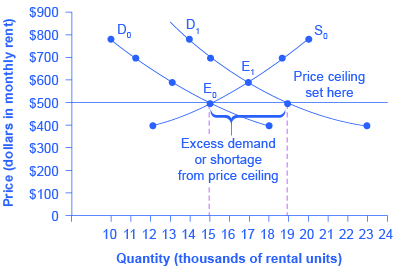The original intersection of demand and supply occurs at e 0 if demand shifts from d 0 to d 1 the new equilibrium would be at e 1 unless a price ceiling prevents the price from rising.
Price floors and ceilings quizlet.
Like price ceiling price floor is also a measure of price control imposed by the government.
Shortage of 50 units.
Start studying chapter 6.
Shortage of 0 units.
This is usually done to protect buyers and suppliers or manage scarce resources during difficult economic times.
Price floors and ceilings are inherently inefficient and lead to sub optimal consumer and producer surpluses but.
Example breaking down tax incidence.
Taxation and dead weight loss.
Surplus of 40 units.
Price floors and price ceilings are price controls examples of government intervention in the free market which changes the market equilibrium.
Price floors and ceilings.
Price floors and price ceilings are government imposed minimums and maximums on the price of certain goods or services.
It is legal minimum price set by the government on particular goods and services in order to prevent producers from being paid very less price.
Price floors and price ceilings.
Price ceiling refer to the figure.
The effect of government interventions on surplus.
This is the currently selected item.
Start studying economics 4.
Taxes and perfectly inelastic demand.
If a price ceiling were set at 12 there would be a.
They each have reasons for using them but there are large efficiency losses with both of them.
Price and quantity controls.
Start studying price floors and price ceilings.
Learn vocabulary terms and more with flashcards games and other study tools.
Learn vocabulary terms and more with flashcards games and other study tools.
Learn vocabulary terms and more with flashcards games and other study tools.
Price ceilings and price floors.
Surplus of 20 units.
Learn vocabulary terms and more with flashcards games and other study tools.
If the price is not permitted to rise the quantity supplied remains at 15 000.
But this is a control or limit on how low a price can be charged for any commodity.




























